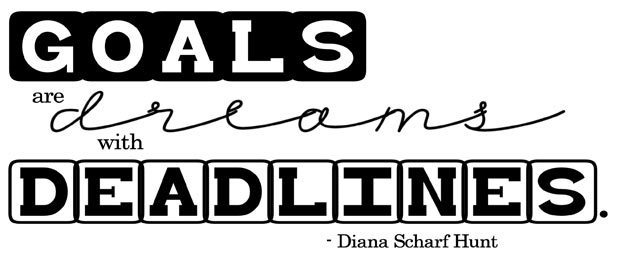Success Advice
7 Ways To Transform Your Goals Into Rock-Solid Systems

You’ve been there.
Maybe you have unfinished novels scattered across your hard drive, or haven’t picked up your guitar in weeks, or have stopped practicing that new language you so desperately wanted to learn.
Goals are easy to conceptualize. It’s easy to convince yourself that this time it’s different.
But it still doesn’t work.
Why is it so hard to actually achieve the goals we set for ourselves? Why do so many of us fail?
Here’s a hint—it’s not about your level of commitment. That’s irrelevant.
When we set goals, we too often plunge head first into the deep end with our eyes on one thing only — the achievement itself.
This, my friend, is why you fail.
You’re approaching your goals the wrong way. Not only that, you’re choosing the wrong kinds of goals to begin with.
Here are 7 ways to transform your goals into rock solid systems.
1. Adopt a systems mindset
Focusing only on the achievement of your goal doesn’t give you the best chance of success.
Scott Adams, in his book How to Fail at Almost Everything and Still Win Big, said that achievement-oriented people “exist in a state of continuous presuccess failure at best, and permanent failure at worst if things never work out.” What he means is that end-state thinking creates a division between progress and achievement.
In other words, if you aren’t winning, you’re failing.
A system is defined as “an organized, purposeful structure that consists of interrelated and interdependent elements.” A systems mindset shifts your thinking away from the end-state and lets you focus on your progress.
To skyrocket your chances of success, you have to be systems-oriented. And you must start with the right kinds of goals.
2. Get big with your goals! Forget being S.M.A.R.T.
Successful companies set long-term strategic goals, called BHAGs (Big, Hairy, Audacious Goals). Consider these classic examples:
• “Crush Adidas.” (Nike, 1960’s)
• “Every book, ever printed, in any language, all available in less than 60 seconds.” (Amazon)
• “I believe that this nation should commit itself to achieving the goal, before this decade is out, of landing a man on the moon and returning him safely to the earth.” (JFK, 1961)
BHAGs are clear, compelling, represent a vision, and inspire tremendous effort.
My favorite example of a personal BHAG comes from Arnold Schwarzenegger before he was famous. When asked what he was going to do after his bodybuilding career was over, he said, “I’m going to be the number-one box office star in Hollywood.” How’s that for big?
S.M.A.R.T. goals (Specific, Measurable, Actionable, Reasonable, and Time-bound) don’t inspire us the way BHAGs do. They are limiting and are often boring.
We need to allow more room in our lives for those BHAGs that excite us, that stimulate our success triggers and enable us to think more creatively about our futures.
When setting your goals, go big. Think BHAG.
3. Get strategic, and layer in your tactics
Strategy gives us the how behind an idea. It propels us forward and guides us where we need to go.
Strategic goals help us achieve our BHAGs because they drive everything we do.
Consider the BHAG, “To live a life of abundance, free of financial burden.” What could be one strategic goal that aligns with this BHAG? How about “make an extra $1000 a month?” Setting this strategic objective could help you achieve your vision of living abundantly.
Tactics, then, comprise the what behind our strategy. Tactics are the specific actions we take based on our strategic objectives.
In the example above, you could brainstorm specific actions to make an extra $1,000 a month — work overtime three days a week, sell one freelance article a week, or shop garage sales on weekends and sell items on eBay for a profit.
The tactics you implement support your strategic goals, which in turn align with and push you toward your BHAGs.
Break these tactics down even further into actionable components that can become habits. For your tactic of selling an article a week, start with a simple action to “write 200 words every day.” Pretty soon, this becomes a habit, and you’ve built a set of behaviors that link your habits to your tactics, your tactics to your strategy, and your strategy to your BHAG.
You’ve taken the initial steps to create a rock-solid system!
But we’re not done yet.

4. Set milestones and celebrate them
Rock-solid systems must contain benchmarks to gauge their effectiveness. How else will you know if your systems are working?
These could be time-bound, such as 30 days in, 90 days in, etc. Or they could be results driven, with intervals set at certain waypoints (5 pounds lost, 10 pounds lost, $100 extra per month, etc.).
How you set your milestones is far less important than the fact that you set them to begin with. We must be able to measure ourselves against the progress we expect to achieve.
And when you reach a milestone, the first thing you should do is celebrate! Don’t let small wins pass you by.
Every gain, no matter how incremental, is movement in the right direction. I can’t emphasize this point enough. If you don’t make the effort to cheer for yourself, then I would question whether or not you’ve set the right goal or have a clear vision.
5. Assess your progress and don’t be afraid to pivot.
If your system isn’t working, whether you scrap it or tweak it is up to you. If the probability of reaching your next milestone is low, you might need to make some significant adjustments.
Perfectly fine.
One of the beautiful things about systems is that they’re flexible. If something isn’t working, try a different approach.
Entrepreneurs do this quite well. It’s commonplace to hear of serial entrepreneurs who failed miserably time and again until they implemented the right system.
This is another reason why I love BHAGs. They help me keep my eye on the prize and worry less about the small stuff.
6. Get an accountability partner (or team) and solicit feedback.
One pair of hands alone can’t build rock-solid systems. Sometimes we just need someone to push us.
If you work alone, you know how easy it is to anchor yourself on one concept or idea.
We create more value when we’re able to share our thoughts and ideas with others.
An accountability partner or team can be like your own personal board of directors. They have your best interests at heart, and if you have a great partner, they won’t hesitate to tell you when something is broken.
So outline your system for a trusted friend or mentor and ask, “What do you think?” And check in with them on a regular basis.
I guarantee you’ll get better results.
7. Focus on the journey
With systems-oriented thinking, you will not have immediate gratification. And that’s okay. Working towards BHAGs are about pushing yourself, immersing yourself in your values and working toward your envisioned future.
Systems force you to focus on your journey and help you build habits that align with your goals. And once you’ve built those systems, you will never worry about achieving your goal—because you will!
The system won’t allow you to fail.
You now have a framework for building rock-solid systems, but the rest is up to you. It isn’t enough to just read these steps, nod your head in agreement and move onto another topic.
It’s true – setting goals and implementing rock-solid systems is a lot of work. But the payoffs are worth ten times that effort.
Achieving your goals feels great. Building systems that take you beyond your goals feels even better.
Rock-solid systems are life changing. If you’re willing to put in the hours, you’ll become a goal-getting machine.
When will you start?
What techniques have you found effective in helping you hit your big goals? Share them in the comments field below.
Feature Image: Daniel Craig – Skyfall
Success Advice
How to Choose the Best Affiliate Programs for Your Blog
If you follow these steps, you can create an affiliate marketing plan that makes money, fits well with your content, and connects with your readers

Picking the right affiliate programs for your blog is really important. It can make a big difference in how much money you can make and how much your readers get out of your blog. With so many choices out there, deciding which ones to go with can be tricky.
This guide is here to make it easier for you. It will give you clear steps and helpful tips to choose affiliate programs that fit well with what your blog is about, what your readers like, and what you stand for.
For more articles on this theme, please head over to this blog https://blog.partners1xbet.com/.
Understanding Affiliate Marketing
Before you start picking affiliate programs, it’s important to really understand what affiliate marketing is and how it works.
Basically, affiliate marketing is when you promote a product or service on your blog, and then you get paid a little bit every time someone buys something or does something because you recommended it.
It’s great for both the person selling the product and the blogger, because the seller gets more sales with low risk, and the blogger can make money from their blog.
How to Choose the Right Affiliate Programs for Your Blog
1. Assess Your Niche and Audience
The key to doing well in affiliate marketing starts with really knowing what your blog is about and who reads it. Consider the following:
- Your blog’s content: What topics do you cover? Ensure the products or services you promote are relevant.
- Your audience’s interests and needs: What solutions are they seeking? Choose affiliate programs that offer products or services that solve their problems or enhance their lives.
2. Research Potential Affiliate Programs
Once you know what your blog is about and what your readers want, start looking for affiliate programs. Choose ones that are well-known for good products, great customer service, and helpful support for affiliates. Resources to find these programs include:
- Affiliate networks like ShareASale, Commission Junction, and ClickBank.
- Direct searches for “[Your Niche] affiliate programs” in search engines.
- Recommendations from other bloggers in your niche.
3. Evaluate the Commission Structure
The commission structure is a critical factor to consider. Look for programs that offer competitive rates that make your efforts worthwhile. Consider:
- The percentage of commission per sale.
- Whether the program offers a flat rate per action (e.g., per sign-up).
- The cookie duration, which affects how long after a click you can earn commissions on sales.
4. Consider the Program’s Reputation and Sureness
Join affiliate programs with a solid reputation for quality and sureness. This not only ensures that you’re promoting good products but also that you’ll be paid on time. You can:
- Read reviews from other affiliates.
- Check the program’s history and background.
- Look for any complaints or issues reported online.
5. Analyze the Support and Resources Offered
A good affiliate program gives you things like ads to use, training on their products, and helpful managers. Having access to these resources can really help you do a better job at promoting their products.
6. Understand the Terms and Conditions
Before signing up, thoroughly review the program’s terms and conditions. Pay close attention to:
- Payment thresholds and methods.
- Any restrictions on how you can promote their products.
- The program’s policy on affiliate marketing on social media platforms.
7. Test the Product or Service
If possible, test the product or service before promoting it. This firsthand experience allows you to offer genuine charge and build trust with your audience.
8. Look for Recurring Commission Opportunities
Some affiliate programs pay you again and again for subscriptions or services that charge fees regularly. These can provide a more stable income compared to one-time sales commissions.
Implementing Your Choice
After choosing the best affiliate programs, the next step is to smoothly include your affiliate marketing in your content plan. This includes:
- Creating valuable content that naturally incorporates affiliate links.
- Disclosing your affiliate affairs transparently to maintain trust with your audience.
- Tracking your results to understand what works best for your audience and adjusting your strategy accordingly.
Picking the best affiliate programs for your blog involves careful planning, research, and making sure they match what your audience likes and needs.
If you follow these steps, you can create an affiliate marketing plan that makes money, fits well with your content, and connects with your readers.
The real key to doing well with affiliate marketing isn’t just about the products you talk about, but also how much your audience trusts and values your advice.
With enough time, patience, and hard work, your blog can grow into a successful space that earns a good amount of affiliate money and helps your readers choose the right products.
Success Advice
The Power of Ethical Leadership: How Integrity Drives Success
By leading with integrity and ethics, leaders create an environment where employees feel excited to come to work

What differentiates a positive organizational culture that enjoys a clean reputation and long-term success from a toxic culture drowning in scandals, mistrust, and legal fines? (more…)
Success Advice
10 Landing Page Hacks Experts Are Using to Generate Leads
Crafting a landing page that converts is both an art and a science

If you are in the online marketing world, you know the importance of a high-quality landing page. It’s like a secret sauce that can turn a casual user into a solid lead. I will walk you through ten great tips that have worked wonders for me and could do the same for you in creating landing pages that generate leads. (more…)
Success Advice
An Easy to Follow 8 Step Strategy for Creative Problem Solving
A complete process of creative problem-solving encompasses finding problems, developing creative solutions, and implementing your solutions

No matter where you look around the world today, entrepreneurs face a common challenge: The need to stand out from their competitors and win over customers. (more…)
-

 Life4 weeks ago
Life4 weeks agoThe Power of Elevating Others: Steps to Change Your Life for the Better
-

 Life4 weeks ago
Life4 weeks agoThe Best Techniques to Boosting Your Memory in a Busy World
-

 Success Advice3 weeks ago
Success Advice3 weeks agoAn Easy to Follow 8 Step Strategy for Creative Problem Solving
-

 Entrepreneurs4 weeks ago
Entrepreneurs4 weeks agoCrisis-Proof Your Business Now: Essential Strategies for Every Entrepreneur
-

 Success Advice3 weeks ago
Success Advice3 weeks ago10 Landing Page Hacks Experts Are Using to Generate Leads
-

 Entrepreneurs2 weeks ago
Entrepreneurs2 weeks agoThe Mindset Shifts Required to Become a Successful Online Entrepreneur
-

 Success Advice2 weeks ago
Success Advice2 weeks agoThe Power of Ethical Leadership: How Integrity Drives Success
-

 Entrepreneurs2 weeks ago
Entrepreneurs2 weeks ago6 Hacks to Boost Your Productivity as a Business Owner































39 Comments